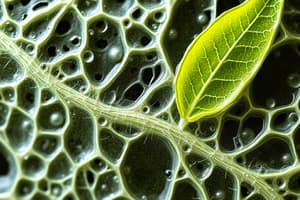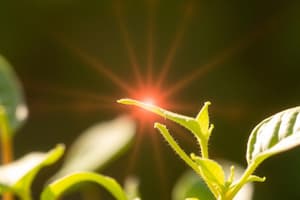Podcast
Questions and Answers
Which type of photosynthesis is adapted for high light intensity and temperatures?
Which type of photosynthesis is adapted for high light intensity and temperatures?
- C2
- C4 (correct)
- CAM
- C3
The primary pigment involved in photosynthesis is chlorophyll, which absorbs green light.
The primary pigment involved in photosynthesis is chlorophyll, which absorbs green light.
False (B)
What is the final product of the Calvin Cycle that is used to form glucose?
What is the final product of the Calvin Cycle that is used to form glucose?
G3P
Photosynthesis occurs in the __________ of chloroplasts during the Calvin Cycle.
Photosynthesis occurs in the __________ of chloroplasts during the Calvin Cycle.
Match the following photosynthesis types with their characteristics:
Match the following photosynthesis types with their characteristics:
What occurs during light-dependent reactions in photosynthesis?
What occurs during light-dependent reactions in photosynthesis?
Light intensity below optimal levels can enhance the rate of photosynthesis.
Light intensity below optimal levels can enhance the rate of photosynthesis.
During __________, water is split and oxygen is released in the light-dependent reactions.
During __________, water is split and oxygen is released in the light-dependent reactions.
Study Notes
Photosynthesis
Photosynthesis in Different Environments
-
Types of Photosynthesis:
- C3: Most common, occurs in a wide range of plants (e.g., wheat, rice).
- C4: Adapted for high light intensity and temperatures (e.g., corn, sugarcane).
- CAM: Adapted for arid conditions, opens stomata at night (e.g., succulents).
-
Factors Influencing Photosynthesis:
- Light Availability: Varies greatly in environments (forests, deserts).
- Water and CO2: Availability affects different plant types.
- Temperature: Affects enzymatic activities involved in photosynthesis.
Impact of Light Intensity
- Light Saturation: Photosynthesis increases with light intensity up to a saturation point.
- Optimal Range: Each plant species has an optimal light intensity range.
- Limiting Factor: Light intensity below optimal levels can limit photosynthesis rates.
- Photoinhibition: Excessive light can damage chlorophyll and reduce photosynthetic efficiency.
Chlorophyll Function
- Pigment Type: Primary pigment in photosynthesis; absorbs light.
- Light Absorption: Absorbs blue-violet and red wavelengths; reflects green light (appears green).
- Role in Energy Transfer: Converts light energy into chemical energy, enabling the formation of glucose from CO2 and water.
Light-dependent Reactions
- Process Location: Occur in thylakoid membranes of chloroplasts.
- Input Requirements: Light, water, and NADP+.
- Key Outcomes:
- Production of ATP (via photophosphorylation).
- Production of NADPH (from NADP+).
- Release of oxygen (O2) as a byproduct from water splitting.
Calvin Cycle
-
Process Location: Occurs in the stroma of chloroplasts.
-
Key Inputs: ATP, NADPH, and CO2.
-
Phases:
- Carbon Fixation: CO2 is attached to ribulose bisphosphate (RuBP).
- Reduction Phase: ATP and NADPH are used to convert 3-phosphoglycerate into glyceraldehyde-3-phosphate (G3P).
- Regeneration Phase: RuBP is regenerated to continue the cycle.
-
Final Product: G3P is used to form glucose and other carbohydrates.
Photosynthesis in Different Environments
- C3 photosynthesis is the most common type, used by a wide range of plants including wheat and rice.
- C4 photosynthesis is adapted to high light intensity and temperatures, and is found in plants like corn and sugarcane.
- CAM photosynthesis is adapted to arid conditions, and involves opening stomata at night to minimize water loss.
- Light availability, water and CO2 availability, and temperature all influence photosynthesis.
Impact of Light Intensity
- Light saturation is the point at which further increases in light intensity do not result in increased photosynthesis.
- Each plant species has an optimal light intensity range.
- Low light intensity below the optimal range can be a limiting factor for photosynthesis.
- Photoinhibition occurs when excessive light damages chlorophyll and reduces photosynthetic efficiency.
Chlorophyll Function
- Chlorophyll is the primary pigment in photosynthesis, responsible for absorbing light.
- Chlorophyll absorbs blue-violet and red wavelengths, and reflects green light, causing plants to appear green.
- Chlorophyll converts light energy into chemical energy, driving the formation of glucose from CO2 and water.
Light-dependent Reactions
- The light-dependent reactions occur in the thylakoid membranes of chloroplasts.
- They require light, water, and NADP+ as inputs.
- ATP (via photophosphorylation), NADPH, and oxygen (O2) are produced as outcomes.
Calvin Cycle
- The Calvin cycle occurs in the stroma of chloroplasts.
- It uses ATP, NADPH, and CO2 as inputs.
- The Calvin cycle has three phases:
- Carbon fixation: CO2 is attached to ribulose bisphosphate (RuBP).
- Reduction phase: ATP and NADPH convert 3-phosphoglycerate into glyceraldehyde-3-phosphate (G3P).
- Regeneration phase: RuBP is regenerated to continue the cycle.
- G3P is used to form glucose and other carbohydrates.
Studying That Suits You
Use AI to generate personalized quizzes and flashcards to suit your learning preferences.
Description
This quiz explores the various types of photosynthesis, including C3, C4, and CAM adaptations in plants. Learn how light availability, water, carbon dioxide, and temperature influence the photosynthetic process. Test your knowledge on light intensity's impact and optimal conditions for different species.




